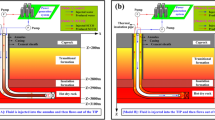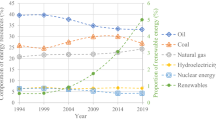Abstract
Hot dry rock, as a renewable and sustainable energy source, can alleviate resource shortages and environmental pollution. Based on data from the Qiabuqia geothermal field and an established thermal-hydrological-mechanical coupled mathematical model, a novel horizontally layered enhanced geothermal system (EGS) is proposed and compared with the conventional double vertical well EGS. Under the simulated conditions in this paper, the comprehensive heat recovery performance of the horizontally layered EGS is significantly better than that of the double vertical well EGS. Specifically, although the average production temperature of the double vertical well EGS is higher than that of the horizontally layered EGS in the attenuation stage, the heat power output of the horizontally layered EGS ranges from 6.10 MW to 12.25 MW, which is 1.36 to 1.67 times that of the double vertical well EGS. Additionally, the heat recovery rate of the horizontally layered EGS is 6.63% higher than that of the double vertical well EGS and is thus more economical. Finally, parametric analysis was performed to investigate the influence of the controllable parameters on heat recovery for the horizontally layered EGS. The heat power output and heat extraction ratio are proportional to the pressure difference and well spacing and inversely proportional to the injection fluid temperature. The thermal power output is most greatly influenced by the pressure difference, followed by the well spacing and injection fluid temperature. The effects of the pressure difference and well spacing on the heat recovery rate are almost the same, and the injection fluid temperature has no effect.
Similar content being viewed by others
References
Lin W.J., Liu Z.M., Ma F., et al., An estimation of HDR resources in China’s mainland. Acta Geoscientica Sinica, 2012, 33(5): 807–811.
Gao P., Analysis of rock thermal physical parameters and research on multi-field thermal effect coupled model, PhD. thesis. Jilin University, Changchun, China, 2015.
Wang J., Hu S., Pang Z., et al., Estimate of geothermal resources potential for hot dry rock in the continental area of China. Science & Technology Review, 2012, 30(32): 25–31.
Xu T.F., Hu Z.X., Li S.T., et al., Enhanced geothermal system: international progresses and research status of China. Acta Geologica Sinica, 2018, 92(9): 1936–1947.
Qu Z.Q., Zhang W., Guo T.K., Influence of different fracture morphology on heat mining performance of enhanced geothermal systems based on COMSOL. International Journal of Hydrogen Energy, 2017, 42(29): 18263–18278.
Xu T., Zhang Y., Yu Z., et al., Laboratory study of hydraulic fracturing on hot dry rock. Science & Technology Review, 2015, 33(19): 35–39.
Wang X.X., Wu N.Y., Su Z., Zeng Y.C., Progress of the enhanced geothermal systems (EGS) development technology. Progress in Geophysics, 2012, 27: 355–362.
Sun Z., Lu S., Xu Y., et al., A thermo-hydro-mechanical coupling model for numerical simulation of enhanced geothermal systems. Journal of China University of Petroleum, 2016, 40(6): 109–117.
Zeng Y.C., Su Z., Wu N.Y., Numerical simulation of heat production potential from hot dry rock by water circulating through two horizontal wells at desert peak geothermal field. Energy, 2013, 56: 92–107.
Magnenet V., Fond C., Genter A., Schmittbuhl J., Two-dimensional THM modelling of the large scale natural hydrothermal circulation at Soultz-sous-Forêts. Geothermal Energy, 2014, 2(1): 17.
Benim A.C., Cicek A., Eker A.M., A computational investigation of the thermohydraulics of an EGS project. Journal of Thermal Science, 2018, 27(5): 405–412.
Rawal C., Ghassemi A., A reactive thermo-poroelastic analysis of water injection into an enhanced geothermal reservoir. Geothermics, 2014, 50: 10–23.
Cao W., Huang W., Jiang F., A novel thermal-hydraulic-mechanical model for the enhanced geothermal system heat extraction. International Journal of Heat and Mass Transfer, 2016, 100: 661–671.
Zhang C., Zhang S., Li S., et al., Geothermal characteristics of the Qiabuqia geothermal area in the Gonghe basin, northeastern Tibetan Plateau. Chinese Journal of Geophysics Chinese Edition, 2018, 61(11): 4545–4557.
Sun Z.X., Li B.X., Wang Z.L., Exploration of the possibility of hot dry rock occurring in the Qinghai Gonghe basin. Hydrogeology and Engineering Geology, 2011, 38(2): 119–124.
Xue J.Q., Gan B., Li B.X., Wang Z.L., Geological-geophysical characteristics of enhanced geothermal systems (Hot Dry Rocks) in Gonghe-Guide Basin. Geophysical and Geochemical Exploration, 2013, 37(1): 35–41.
Wang B., Li B.X., Ma X.H., Heat storage temperature and deep prediction of Qinghai Gonghe-guide hot dry rock survey evaluation. Ground Water, 2015, 37(3): 28–30.
Kozeny J., Vber kapillare leitung des wassers im boden. Sitzungsberichte der Wiener Akademie der Wissenschaften, 1927, 136(2a): 271–306.
Carman P.C., Permeability of saturated sands, soils and clays. The Journal of Agricultural Science, 2009, 29(2): 262–273.
McKee C.R., Bumb A.C., Koenig R.A., Stress-dependent permeability and porosity of coal and other geologic formations. Society of Petroleum Engineers, 1988, 3(1): 81–91.
Li S., Fan C., Han J., et al., A fully coupled thermal-hydraulic-mechanical model with two-phase flow for coalbed methane extraction. Journal of Natural Gas Science and Engineering, 2016, 33: 324–336.
Wang Z.L., Study on the coupled thermal-hydrologic-mechanical model in fractured rock mass and its application, M.D. dissertation. China University of Mining and Technology, China, 2015.
Bai B., One-dimensional thermal consolidation characteristics of geotechnical media under non-isothermal condition. Engineering Mechanics, 2005, 22(5): 186–191.
Song X., Shi Y., Li G., et al., Numerical simulation of heat extraction performance in enhanced geothermal system with multilateral wells. Applied Energy, 2018, 218: 325–337.
Song X., Xu Z., Wang M., et al., Experimental study on the wellbore-cleaning efficiency of microhole-horizontal-well drilling. Society of Petroleum Engineers, 2017, 22(4): 1189–1200.
Nair R., Peters E., Šliaupa S., et al., 42nd workshop on geothermal reservoir engineering. Report, Stanford University, Stanford, California, 2017.
Li J., Li G., Huang Z., et al., The self-propelled force model of a multi-orifice nozzle for radial jet drilling. Journal of Natural Gas Science and Engineering, 2015, 24: 441–448.
Dickinson W., Anderson R.R., Dickinson R.W., The ultrashort-radius radial system. SPE Drilling Engineering, 1989, 4(03): 247–254.
Zhang S.G., Li Z.J., Xu Y.H., Three-dimensional numerical simulation and analysis of fluid-heat coupling heat-transfer in fractured rock mass. Journal of Liaoning Technical University, 2011, 32(8): 2507–2511.
Zhao Y., Wang R., Hu Y., et al., 3D numerical simulation for coupled THM of rock matrix-fractured media in heat extraction in HDR. Chinese Journal of Rock Mechanics and Engineering, 2002, 21(12): 1751–1755.
Zhao Y., Feng Z., Feng Z., et al., THM (Thermo-hydro-mechanical) coupled mathematical model of fractured media and numerical simulation of a 3D enhanced geothermal system at 573 K and buried depth 6000–7000 M. Energy, 2015, 82: 193–205.
Rutqvist J., Status of the TOUGH-FLAC simulator and recent applications related to coupled fluid flow and crustal deformations. Computers & Geosciences, 2011, 37(6): 739–750.
Lei H., Xu T., Jin G., TOUGH2Biot — a simulator for coupled thermal-hydrodynamic-mechanical processes in subsurface flow systems: application to CO2 geological storage and geothermal development. Computers & Geosciences, 2015, 77: 8–19.
Zhang S.G., Xu Y.H., 3D finite element model of fluid-heat coupling heat-transfer in fracture rock. Journal of Liaoning Technical University, 2011, 30(4): 505–507.
Ding J.F., Wang S.M., Three-dimensional numerical simulation of deformation-seepage-heat transfer coupling in fractured rock. Annual Meeting of Chinese Geoscience Union, Beijing, China.
Baria R., Baumgärtner J., Rummel F., et al., HDR/HWR reservoirs: concepts, understanding and creation. Geothermics, 1999, 28(4): 533–552.
Acknowledgments
This study was supported by the Fundamental Research Funds for the Central Universities (No. 2020ZDPY0222)
Author information
Authors and Affiliations
Corresponding author
Rights and permissions
About this article
Cite this article
Gao, K., Liu, W., Ma, T. et al. Numerical Simulation Study of a Novel Horizontally Layered Enhanced Geothermal System: A Case Study of the Qiabuqia Geothermal Area, Qinghai Province, China. J. Therm. Sci. 30, 1328–1340 (2021). https://doi.org/10.1007/s11630-021-1480-x
Received:
Published:
Issue Date:
DOI: https://doi.org/10.1007/s11630-021-1480-x




